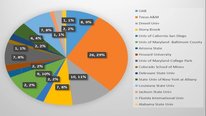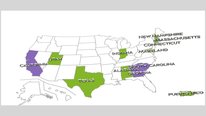- Sam Catherine Johnston
- http://www.cast.org/about/staff/sam-johnston.html
- Research Scientist / Co-Principal Investigator
- Inquiry Primed: Mitigating the Effects of Stereotype Threat in Science
- CAST
- Samantha Daley
- http://www.cast.org/about/staff/samantha-daley.html
- Director of Research / Principal Investigator
- Inquiry Primed: Mitigating the Effects of Stereotype Threat in Science
- CAST
Public Discussion
Continue the discussion of this presentation on the Multiplex. Go to Multiplex








Gerald Kulm
Senior Professor
Hi. How long was the course and how many teachers participated? What were a couple of specific strategies presented in the course to reduce stereotype threat? What measures did you use to assess teacher response or succes in implementing ideas from the course?
Sam Catherine Johnston
Research Scientist / Co-Principal Investigator
The Inquiry Primed course was a total of 10 weeks and focused on learning about and applying strategies for mitigating stereotype threat in science classrooms. Strategies included using mastery oriented and wise feedback, re-framing tasks, mood reappraisal, self-affirmation, and building students’ collaboration skills.
Each of four 2-week modules of active course work included readings, videos, mitigation activities that teachers used in their classrooms, and small (3-5 teachers) community of practice sessions where teachers talked about how trying mitigation strategies went for them, as well as problem solving. The modules were preceded by an introductory webinar that framed the challenge of stereotype threat in inquiry science, and were followed by a concluding session in which all participants shared their final projects and insights with each other. We had 13 teachers participating in the pilot.
To answer our research questions about usability, feasibility, and fidelity of the professional development, we used data from observations of professional development interactions including observing synchronous meetings using a standard observation protocol with indicators of community of practice engagement, course site usage log data, and analysis of work produced by the teachers in the PD. We also administered a post-test online survey to understand what was and was not effective in terms of the course structure, media and materials, and delivery method.
To answer research questions about the promise of the professional development in improving teachers’ knowledge of stereotype threat, and their motivation for using strategies to mitigate stereotype threat in their classrooms, we pre- and post-tested knowledge of stereotype threat using an online survey. Questions, for example, asked teachers to define stereotype threat and describe a situation in which threat might occur. We also gathered qualitative information through post course interviews with all teachers and course facilitators in the PD on the perceived valued of the mitigation strategies, how they used the stereotype threat mitigation strategies in their science classrooms, and their intentions for continued use. In addition, teachers were asked about ways in which the PD was/was not effective at supporting their efforts to implement the stereotype threat mitigation strategies in their science classrooms. Finally, the “Communicative Interactions” and “Student/Teacher Relationship” subscales of the Reformed Teaching Observation Protocol (RTOP; Sawada, et al., 2002) were used to code direct observations of the grade 8 science classrooms (total observed: 16 class periods for a subset of teachers in the PD) at baseline, half way through the PD, and two weeks after the PD. The RTOP was used to determine if there was any measurable change in communicative interactions in teacher-student relationships in the grade 8 classrooms before and after engaging in the professional development. Data analysis is underway.
Jim Sandherr
Powerful video! Is the web-based PD course available to the public? Would love to check it out!
Sam Catherine Johnston
Research Scientist / Co-Principal Investigator
Thanks, Jim. The course was part of our research so the site is not available to the public. However, there has been so much interest in strategies to mitigate stereotype threat that CAST’s Professional Learning division is considering offering a course on the topic, so stay tuned.
Brian Drayton
Could you say more about what you mean by “the challenge of stereotype threat in inquiry based science”? That is, are there things about that kind of classroom that make stereotype threat particularly salient, or make it easier for teachers to see and address it?
Sam Catherine Johnston
Research Scientist / Co-Principal Investigator
Hi Brian. Stereotype threat — that is, the fear of fulfilling negative expectations about a group — is a recognized obstacle to the academic achievement of learners representing certain minority groups, including women, African Americans and Latino/as, especially in the subjects of science and math. Inquiry science presents special challenges; it is, after all, how real scientists engage in scientific research, it depends on a free and equal exchange of ideas, opinions, and skills, and depends on an ease of interaction in order for it to be most successful. It follows, then, that when some students in inquiry science classes are subject to stereotype threat, some people are discouraged from contributing to group thought, ideas are suppressed, and the inquiry process as a whole suffers. That’s the short term impact, and it’s what the Inquiry Primed PD course addresses through raising awareness of the issue, the research, and effective strategies for teachers and students to practice. The long-term impact is in who continues to participate in science and is evidenced by the decreasing participation and enrollment of these stereotyped groups in inquiry based science classes, majors, and careers. While there is a lot of diversity in middle school in terms of who is participating and achieving, by high school fewer women, African Americans, and Latinos are taking science classes and even fewer go on to major in and have careers in science fields. Mitigating stereotype threat in middle school can help solve this drop off in these groups’ science participation and bring a wider diversity of voices into STEM careers.
Michelle Perry
Researcher
What a fascinating approach to the issue! How were teachers selected for the pilot? Did you encounter any challenges with the pilot? Any plans to scale this up?
Sam Catherine Johnston
Research Scientist / Co-Principal Investigator
Thanks, Michelle; we think it’s fascinating, too! Our pilot teachers were recruited through connections with districts around the country. All of the teachers were volunteers, and in most cases multiple teachers from individual districts took part together. We encountered surprisingly few challenges with the pilot, other than some technical difficulties and one teacher withdrawing due to other obligations.
In terms of scaling up, we are working to determine how to make the course and/or its contents more widely available! Thanks for your questions.
Carolina Milesi
Senior Research Scientist
It’s so great to see a project that targets teachers PD on the issue of stereotype threat! I wonder if you are planning to measure the impact of the intervention on teachers and also their students.
Sam Catherine Johnston
Research Scientist / Co-Principal Investigator
Hi Carolina. I agree with your thoughts about targeting teachers to reduce stereotype threat. Middle school is ground zero for a lot of the impact of stereotype threat and teachers there can have a major impact in reducing it in their classrooms and in providing kids with a framework to think about themselves as learners.
With teachers as the project’s target audience, we’re measuring the project’s impact by pre- and post-testing teachers’ knowledge of stereotype threat, post course interviews on the perceived value and use of stereotype threat mitigation strategies, and class observations. Class observations before, during and two weeks after the course were coded using the “Communicative Interactions” and “Student/Teacher Relationship” subscales of the Reformed Teaching Observation Protocol (RTOP; Sawada, et al., 2002). The RTOP was used to determine if there was any measurable change in communicative interactions in teacher-student relationships in the grade 8 classrooms before and after engaging in the professional development. Data analysis is underway.
In terms of impact on students, since they were not our project target we could not collect student work. However, our participants all shared really inspiring stories of how doing some simple mitigation activities changed the attitude, effort, and sense of identity of their students. Not hard data, for sure, but definitely inspiring, exciting, and fertile ground for next steps!
Suzanna Loper
This seems like a really important and powerful problem to focus on, with the potential for great impact. Thanks for sharing this work, I hope it finds a wide audience!
Sam Catherine Johnston
Research Scientist / Co-Principal Investigator
Thanks, Suzanna! We’re working on the wider dissemination plan for this project now. The reactions that we got from our pilot teachers was so exciting that we know this work can make a real difference for students and teachers.
Further posting is closed as the showcase has ended.